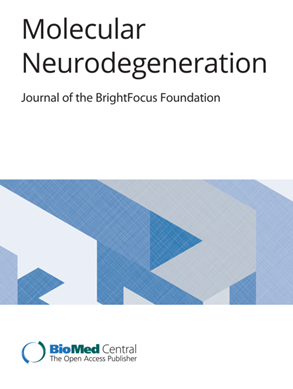路易体痴呆患者基因组DNA损伤标记物与α -突触核蛋白病理之间的相互关系
IF 17.5
1区 医学
Q1 NEUROSCIENCES
引用次数: 0
摘要
DNA损伤和DNA损伤修复(DDR)功能障碍是一种具有广泛细胞生理学意义的损伤,与各种神经退行性疾病有关。α -突触核蛋白(aSyn)是一种与神经退行性疾病(突触核蛋白病)相关的突触前和核蛋白,与DNA双链断裂(DSB)修复有关。然而,尽管在路易体痴呆(DLB)病例的皮质组织中观察到核aSyn病理,但这种核病理是否与DNA损伤的发生一致,此前尚未研究。此外,DLB病例中DNA损伤的具体类型以及DNA损伤对路易体(LB)形成的贡献尚不清楚。在临床和神经病理学证实的DLB病例和对照组的固定外侧颞叶皮层以及3月龄的症状前A30P-aSyn小鼠的皮质组织中评估DNA损伤和aSyn病理。对DLB和对照组的冷冻颞外侧皮层进行核分离、western blotting、aSyn种子扩增和质谱分析。我们在DLB颞叶皮层检测到种子态核aSyn和核丝氨酸-129磷酸化升高,同时在神经元和非神经元细胞群体中发现DSBs的积累。症状前A30P小鼠的皮质组织中也存在DNA损伤,表明这是一种与致病性aSyn密切相关的早期损伤。引人注目的是,在死后的DLB组织中,基因组DNA损伤来源的细胞质DNA (CytoDNA)标记在大多数lb中都很明显。观察到的细胞病理与相关DDR蛋白的细胞核上调一致,特别是涉及碱基切除修复和DSB修复途径的蛋白。总的来说,我们的研究证明了与种子相关的病理性核aSyn的积累,以及核DNA损伤和DNA损伤衍生的细胞DNA物种在细胞质aSyn病理中的潜在参与。最终,我们的研究支持了aSyn病理与核DNA损伤之间相互关系的假设,并强调了DNA损伤在与DLB以及其他突触核蛋白病相关的病理机制中的潜在作用,为诊断和治疗开辟了新的可能性。本文章由计算机程序翻译,如有差异,请以英文原文为准。
A reciprocal relationship between markers of genomic DNA damage and alpha-synuclein pathology in dementia with Lewy bodies
DNA damage and DNA damage repair (DDR) dysfunction are insults with broad implications for cellular physiology and have been implicated in various neurodegenerative diseases. Alpha-synuclein (aSyn), a pre-synaptic and nuclear protein associated with neurodegenerative disorders known as synucleinopathies, has been associated with DNA double strand break (DSB) repair. However, although nuclear aSyn pathology has been observed in cortical tissue of dementia with Lewy body (DLB) cases, whether such nuclear pathology coincides with the occurrence of DNA damage has not previously been investigated. Moreover, the specific types of DNA damage elevated in DLB cases and the contribution of DNA damage towards Lewy body (LB) formation is unknown. DNA damage and aSyn pathology were assessed in fixed lateral temporal cortex from clinically and neuropathologically confirmed DLB cases and controls, as well as in cortical tissue from young 3-month-old presymptomatic A30P-aSyn mice. Frozen lateral temporal cortex from DLB and control cases was subject to nuclear isolation, western blotting, aSyn seed amplification and proteomic characterisation via mass spectrometry. We detected seed-competent nuclear aSyn, and elevated nuclear serine-129 phosphorylation in DLB temporal cortex, alongside the accumulation of DSBs in neuronal and non-neuronal cellular populations. DNA damage was also present in cortical tissue from presymptomatic A30P mice, demonstrating it is an early insult closely associated with pathogenic aSyn. Strikingly, in postmortem DLB tissue, markers of genomic DNA damage-derived cytoplasmic DNA (CytoDNA) were evident within the majority of LBs examined. The observed cellular pathology was consistent with nuclear upregulation of associated DDR proteins, particularly those involved in base excision repair and DSB repair pathways. Collectively our study demonstrates the accumulation of seed-competent pathological nuclear associated aSyn, alongside nuclear DNA damage and the potential involvement of DNA damage derived cytoDNA species in cytoplasmic aSyn pathology. Ultimately, our study supports the hypothesis of a reciprocal relationship between aSyn pathology and nuclear DNA damage and highlights a potential underlying role for DNA damage in pathological mechanisms relevant to DLB, as well as other synucleinopathies, opening novel possibilities for diagnosis and treatment.
求助全文
通过发布文献求助,成功后即可免费获取论文全文。
去求助
来源期刊

Molecular Neurodegeneration
医学-神经科学
CiteScore
23.00
自引率
4.60%
发文量
78
审稿时长
6-12 weeks
期刊介绍:
Molecular Neurodegeneration, an open-access, peer-reviewed journal, comprehensively covers neurodegeneration research at the molecular and cellular levels.
Neurodegenerative diseases, such as Alzheimer's, Parkinson's, Huntington's, and prion diseases, fall under its purview. These disorders, often linked to advanced aging and characterized by varying degrees of dementia, pose a significant public health concern with the growing aging population. Recent strides in understanding the molecular and cellular mechanisms of these neurodegenerative disorders offer valuable insights into their pathogenesis.
 求助内容:
求助内容: 应助结果提醒方式:
应助结果提醒方式:


